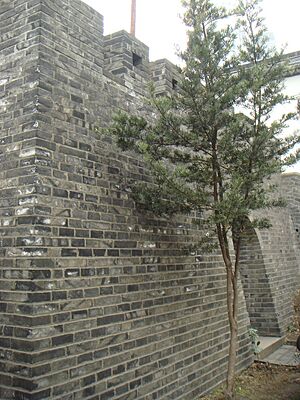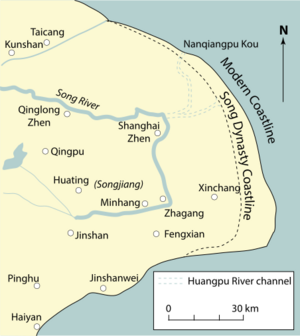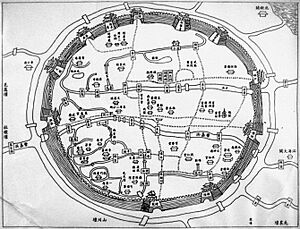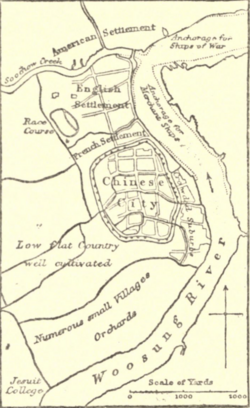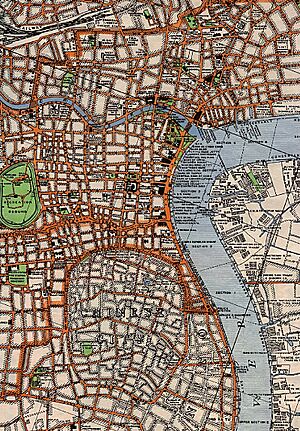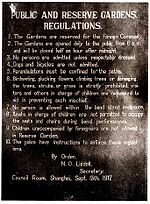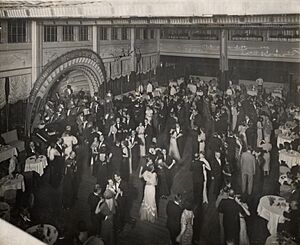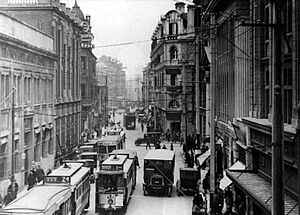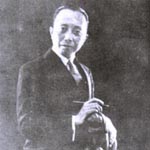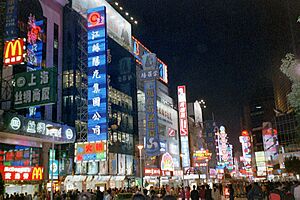History of Shanghai facts for kids
The history of Shanghai goes back over a thousand years and shows how modern China grew. Shanghai started as a small farming village. Later, during the Qing dynasty (1644–1912), it became one of China's most important trading ports. Even though it was part of China, foreign countries often controlled the city through a rule called extraterritoriality, which meant their citizens followed their own laws, not China's. Since China's economic changes in the early 1990s, Shanghai has grown into a major financial center in Asia and the world's busiest port for shipping containers.
Contents
Shanghai's Early Beginnings
About 8,000 years ago, only the western part of what is now Shanghai was dry land. This land was formed by mud from an ancient lake. The central area of Shanghai was still underwater around 3,000 years ago.
The first people lived here around 5000 to 3300 BCE. Archaeologists found the skeleton of one of Shanghai's earliest residents, a man from that time, in the Qingpu District.
By the 300s and 400s CE, during the Eastern Jin dynasty, a busy fishing industry grew along the Song River, which is now called Suzhou Creek. This creek was important because it was close to the Yangtze River, China's largest waterway. The creek was known as Hu, which means a fishing trap. Today, Hu is still used as a short name for Shanghai, like on car license plates.
The first military base in this area, Qinglong Zhen, was built in 746 during the Tang dynasty. This showed that the region was becoming more important.
In 1074, Emperor Shenzong of Song set up a Marine Office and a Goods Control Bureau. This office helped manage trade and taxes. Because it was close to Hangzhou, which was the capital of the Southern Song dynasty, the town grew very rich and was even called "Little Hangzhou."
Shanghai officially became a city in 1291 during the Yuan dynasty. Several villages joined together to form Shanghai County in the modern city center. This new city had about 300,000 people, many of whom worked in shipping.
Shanghai in the Ming Dynasty
By the early 1400s, Shanghai was important enough for engineers to start digging and cleaning the Huangpu River. In 1553, a city wall was built around the Old Town to protect it from Japanese pirates called Wokou.
Shanghai first met Jesuits (a group of Catholic priests) in 1603. A local scholar named Xu Guangqi was baptized by a Jesuit priest. Xu later gave some of his land to the Catholic Church. This area is now called Xujiahui, meaning "Xu family village." By 1644, Shanghai was a major center for cotton and textiles, with a population of about 200,000 people.
Shanghai in the Qing Dynasty
During the late Qing dynasty, Shanghai's economy started to compete with other big markets like Suzhou. In the 1700s and early 1800s, Shanghai exported cotton, silk, and other goods to places as far away as Polynesia and Persia.
In 1832, the East India Company looked at Shanghai as a possible trading center. However, Chinese officials refused them. China tried to stop the opium trade, which led to the First Opium War (1839–1842) with the United Kingdom. After the British won, the Treaty of Nanking opened five Chinese ports, including Shanghai, to British merchants.
Soon, other Western countries like France, America, and Germany also signed treaties. They set up their own areas in Shanghai called sovereign concessions. In these areas, foreigners were not subject to Chinese laws. The British set up their area in 1845, the Americans in 1848, and the French in 1849. The first Western hotel, Richards' Hotel, opened in 1846. In 1850, the first English newspaper, the North China Herald, started.
In 1853, a rebel group called the Small Swords Society took over Shanghai. This fighting damaged the countryside but left the foreign areas untouched.
In 1854, Western businessmen formed the Shanghai Municipal Council. This group managed things like road repairs and trash collection in the foreign areas. In 1863, the American and British areas joined to form the Shanghai International Settlement. Its waterfront became the famous Bund. The French area stayed separate, and the Chinese still controlled the original walled city. By the late 1860s, the Shanghai Municipal Council, controlled by foreigners, was largely running the city. Chinese people living in the International Settlement were not allowed to join the council until 1928.
China's first railway, the Woosung "Road" railway, was built in 1876. However, the Chinese government ordered it to be taken apart in 1877. The telegraph line that ran along the railway, also China's first, was allowed to stay.
By the mid-1880s, the Shanghai Municipal Council controlled many city services like gas, electricity, and water.
After the First Sino-Japanese War, Japan also became a foreign power in Shanghai and built the first factories there. This defeat also pushed China to modernize faster.
Shanghai in the Republic of China Era
The Xinhai Revolution in 1911 led to the creation of the Republic of China. During this time, Shanghai became a very important city for modern China.
By 1936, Shanghai was one of the world's largest cities with 3 million people. Only a small number, about 35,000 to 50,000, were Europeans. But these Europeans controlled half the city due to special treaties. Many White Russians came to Shanghai after the 1917 Russian Revolution. By the 1930s, there were about 35,000 people of Russian origin. Many Jewish refugees from Nazi Germany also arrived in the 1930s.
The city was divided into a more European western half and a more Chinese eastern half. New inventions like electricity and trams quickly appeared. Westerners helped turn Shanghai into a big city. British and American businessmen made a lot of money in trade and finance. Shanghai handled half of China's imports and exports.
Europeans and Americans living in Shanghai were called Shanghailanders. The Public Garden, China's first public park, was for many years only for foreign nationals. The International Settlement was built in a British style, with a large racetrack where People's Square is today. A new group of Chinese people, called compradors, worked as important go-betweens for Western companies. Many compradors helped modernize China. Shanghai was the biggest financial city in East Asia.
Shanghai's Chinese Society
Chinese society was organized into groups based on where people came from, called native place associations. These groups protected the interests of traders from the same hometowns. They had their own customs. The Chinese government had little control because foreign governments controlled the economy. Instead, these native place associations controlled society.
The "Paris of the East"
In the 1920s and 1930s, Shanghai was known as "The Paris of the East, the New York of the West." Shanghai became a special city in 1927. The city's industry and financial power grew because merchants controlled the city, while the rest of China was divided by warlords.
Shanghai became a center for new art forms like Chinese cinema, Chinese animation, and Chinese popular music. The buildings were designed in British and American styles. Many grand buildings on The Bund were built or renovated during this time. The city developed a unique look.
The British novelist J. G. Ballard, who grew up in Shanghai then, remembered it as a place where "Anything was possible, and everything could be bought and sold." This time inspired many of his later stories.
Shanghai became the commercial center of East Asia, attracting banks from all over the world. When movies and books show the "golden days" of old Shanghai, they usually mean this time.
Power Struggles in Shanghai
Shanghai was also a center for opium smuggling in the 1920s.
People in Shanghai started to dislike the foreign presence. In 1919, protests by the May Fourth Movement led to new ideas challenging Chinese traditions. The Chinese Communist Party was founded in Shanghai in 1921.
The Nationalist leader Chiang Kai-shek worked with a powerful gang called the Green Gang. This gang acted against the Communists and labor unions. Many Communists were killed in a surprise attack in 1927. Suspected Communists were shot, and many, including Zhou Enlai, fled the city.
In the late 1920s and early 1930s, new modern neighborhoods were built north of the foreign areas. Chiang Kai-shek often demanded large amounts of money from Shanghai's financial world. When bankers and merchants stopped investing in the army in 1928, Chiang took control of their businesses.
Chiang Kai-shek's rule became more controlling. The power of gangs grew, especially the Green Gang leader Du Yuesheng. Chiang worked with these gangs to control Chinese society. This meant gangs often caused strikes and even took over the Shanghai Stock Exchange.
Greater Shanghai Plan
In 1927, the Nationalist Government planned to develop land in the northeast of the city near the Huangpu River. This plan, called the Greater Shanghai Plan, aimed to make Shanghai a global commercial center. It used ideas from British urban planning.
End of Old Shanghai (1937–1945)
World War II and Japanese Control
The Imperial Japanese Navy Air Service bombed Shanghai on January 28, 1932, to stop Chinese student protests. The Chinese fought back in what was called the January 28 Incident. A ceasefire was agreed upon in May.
During the Second Sino-Japanese War, the Chinese parts of the city fell after the 1937 Battle of Shanghai. The foreign areas became a "Solitary Island" where many foreign businesses continued to operate. When the Pacific War began, Japan took over the foreign areas of Shanghai on December 8, 1941. They took control of most banks and forced people to exchange Chinese money for Japanese-controlled money.
There were many assassinations of Chinese officials who worked with the Japanese. Shanghai suffered less than other cities during World War II. The Japanese tried to keep life somewhat normal.
During World War II, the foreign areas offered a safe place for European refugees without visas. It was one of the few places in the world open to Jews at that time. However, under pressure from Nazi Germany, the Japanese moved the Jews to the Shanghai Ghetto in late 1941, where hunger and diseases were common. The Japanese were harsher on British, American, and Dutch people. These people lost their privileges and were eventually held in camps in 1943. Shanghai remained under Japanese control until Japan surrendered on August 15, 1945.
After the Japanese left, Chinese Nationalist forces sometimes looted the city.
End of Foreign Control
After the attack on Pearl Harbor, the Japanese ended all foreign control in Shanghai except for the French. This was made official by a treaty in 1943. The French gave up their control in 1946 after World War II ended.
Early Communist Rule (1949–1980s)
Communist Takeover

In the final stages of the Chinese Civil War, the People's Liberation Army took control of Shanghai on May 25, 1949. The city's defenders lost many soldiers and could not fight street-to-street.
Many people in Shanghai supported the Kuomintang. One of the first actions by the Communists was to arrest people they considered enemies. Places like the Canidrome, once elegant ballrooms, were used for mass arrests. Thousands of homeless people, criminals, and rickshaw drivers were arrested starting in December 1949.
Most foreign companies moved their offices from Shanghai to Hong Kong. Even though the Communists first tried to let Shanghai have some freedom, its economy declined. This was due to a blockade and Communist rules on foreign trade.
Shanghai as an Industrial Center
Shanghai became an industrial center in the 1950s and 1960s. However, its economy did not grow much during the Maoist era. Shanghai contributed the most tax money to the government, but this hurt the city's own development and infrastructure. This also meant Shanghai did not get the same economic freedoms as other southern provinces until later.
Shanghai's Modern Growth (1990s–Present)
Shanghai's modern growth really began in 1989 when Jiang Zemin became a top leader. Along with his premier, Zhu Rongji, Jiang started to lower taxes on Shanghai. He encouraged both foreign and Chinese businesses to invest in the city, especially the Lujiazui area of Pudong. He wanted Shanghai to be the economic heart of East Asia and a gateway to China's interior. Since then, Shanghai has led China's development, with its economy growing by 9-15% each year.
Shanghai is China's largest and most important business and industrial city. It has only 0.1% of China's land but provides over 12% of the government's income. It handles more than a quarter of all trade passing through China's ports. In 2010, its population was 23.02 million, a big increase from 2000.
The average family size in Shanghai became smaller in the 1990s. Most of Shanghai's population growth comes from people moving there, not from high birth rates. Shanghai has had one of the lowest birth rates in China for many years.
Shanghai is a very large city in terms of its administrative area. In 2010, it had 16 districts and one county, covering a large land area. Chongming still has a lot of rural land and farmers. Shanghai has the highest population density in China, with many people living close together. It also has the highest rate of urbanization, meaning most of its people live in urban areas.
There has been a huge amount of building in Shanghai, thanks to government investment. Since the 1980s, Shanghai's economy has changed from mostly manufacturing to a mix of industry and services. More people now work in services than in manufacturing.
The fast growth in population, factories, and cars has caused environmental problems. Experts say the main issues are air and water pollution and a lot of trash.
See also
- Shanghai urban planning
- Timeline of Shanghai history
- The Shanghai Document, a film about Shanghai in the early 1920s


